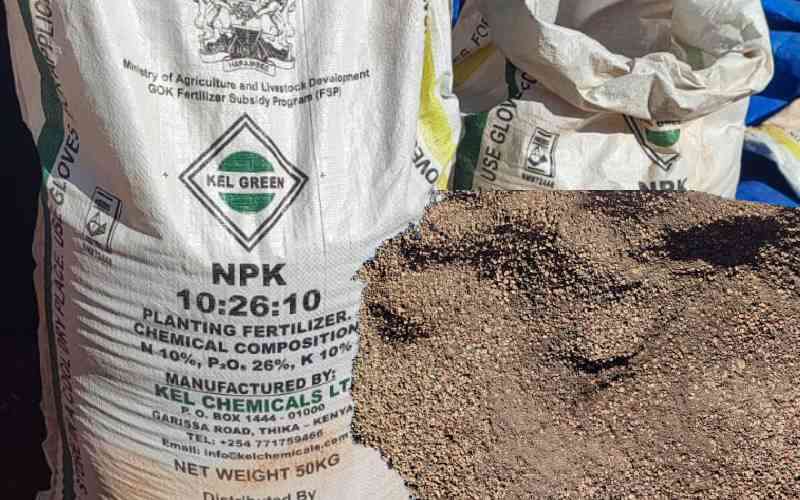There is a magical, aspirational and prayerful line in the first stanza of our national anthem. It runs, in part, “...and may plenty be found within our borders.”
What the founding fathers may not have anticipated is that there would indeed be plenty within our borders, but the problem is in moving the surplus in one corner to the needy in the other end of the country.
That is exactly that the current food crisis in Kenya is all about. It isn't that there is food scarcity in all regions.
In some parts, farmers are stuck with bountiful harvest for lack of market and poor prices.
In another, starvation is real and animals are dying over lack of pasture and dehydration, further worsening the vulnerability of the people because the animals is their lifeline through milk and meat.
And those facing starvation are not a handful; according to government's statistics, they are 1.3 million- vulnerable women, children and old people included.
Harvesting of about 41 million bags of maize is already underway in various parts of the country, according to official government estimates.
The country has another 9.5 million 90-kilogramme bags of maize being held by farmers as a result of poor prices.
On its part, the National Cereals and produce Board (NCPB) currently holds another 731,000 bags of maize and 548 metric tonnes of powdered milk, together with cash enough to buy a further a two million bags.
According to the Agriculture ministry's October food security update, the country has in its food stocks about 1.2 million bags of beans, 2.3 million bags of wheat and about 1 million bags of rice.
Kenya consumes about 3.2 million bags per month, coming to about 40 million bags annually.
According to the government, after the harvest is completed, the country will have food to last through 2017.
"The expected available stocks combined with stocks of other staples such as Irish potatoes, sorghum, millet, cassava, among others, will be enough to last the country up to around June, 2017," Agriculture Cabinet Secretary Willy Bett said.
There are tonnes of vegetables and fresh produce in Uasin Gishu, Nakuru, Kisii, Kakamega, Nyeri, Limuru, Nyandarua and Kericho.
Mr Bett says major irrigation schemes are also preparing to kick start rice harvesting in November.
Stay informed. Subscribe to our newsletter
But even as the country holds onto these huge stocks of food, at a time when more is piling from the fresh harvests, hundreds of thousands of Kenyans are already being ravaged by hunger.
The most affected counties include Kilifi, Kwale, Lamu and Tana River in the Coast region; Garissa, Marsabit and Wajir in the North Eastern region; Makueni, Kitui and Meru in the lower Eastern Region; and parts of Samburu and Kajiado in South Rift as well as Baringo.
GETTING WORSE
The situation is getting worse by the day with reports that about 100 schools in Laikipia are on the verge of being closed down after pupils started migrating towards Mt Kenya and the Aberdares in search of pastures and water.
At the same time, cattle rustlers have started launching attacks on remaining pastoralists in Laikipia North, in what is believed to be a restocking bid.
About 72,000 people in Taita-Taveta County are facing starvation as the country marks Mashujaa Day celebrations.
In Garissa, there have been reports of tens of livestock that have died in the last two weeks due to the pang of the escalating drought in some parts of Garissa County.
Isiolo County has also not been spared and residents are now calling for national and county governments to come to their rescue as the little they had left has ran out as the dry spell persists.
Tigania East MP Mpuru Aburi said hunger was ravaging vast areas in the constituency.
In Narok, maize and beans prices have doubled as compared to two months ago.
And in Baringo, about 5,000 pastoralist families with approximately 10,000 livestock are facing a serious shortage of water and pastures.
 The Standard Group Plc is a
multi-media organization with investments in media platforms spanning newspaper
print operations, television, radio broadcasting, digital and online services. The
Standard Group is recognized as a leading multi-media house in Kenya with a key
influence in matters of national and international interest.
The Standard Group Plc is a
multi-media organization with investments in media platforms spanning newspaper
print operations, television, radio broadcasting, digital and online services. The
Standard Group is recognized as a leading multi-media house in Kenya with a key
influence in matters of national and international interest.
 The Standard Group Plc is a
multi-media organization with investments in media platforms spanning newspaper
print operations, television, radio broadcasting, digital and online services. The
Standard Group is recognized as a leading multi-media house in Kenya with a key
influence in matters of national and international interest.
The Standard Group Plc is a
multi-media organization with investments in media platforms spanning newspaper
print operations, television, radio broadcasting, digital and online services. The
Standard Group is recognized as a leading multi-media house in Kenya with a key
influence in matters of national and international interest.








